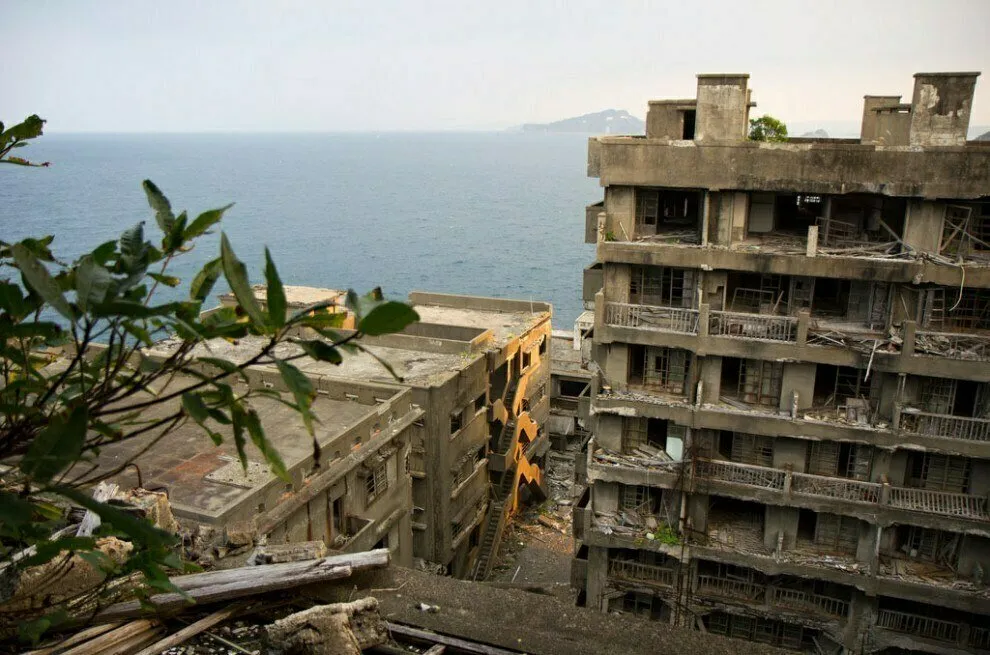There can be your advertisement
300x150
Abandoned Paradise: What Hides the Island of Hasingama, Left Behind 50 Years Ago
Dark ghost city attracting tourists
In the East China Sea, just 15 kilometers off the Japanese city of Nagasaki, a peculiar silhouette rises that resembles a warship. This is not a battleship or cruiser, although locals call it exactly that — Gunkanjima, meaning "cruiser island." Before us is Hasingama — a small piece of land that in half a century transformed from a thriving industrial center into a dark ghost city attracting tourists, filmmakers, and lovers of mysterious places from all over the world.
From a modest rock to an industrial wonder
Until the beginning of the 19th century, Hasingama was only a small rock in the sea where birds nested and fishermen occasionally stopped. Everything changed in 1810 when coal deposits were discovered on it. From that moment, the history of transforming a lifeless chunk of stone into one of the most densely populated places on the planet begins.
The real development of the island began in 1890, when it was purchased by the Mitsubishi Company. The corporation launched a large-scale development program: mines were built, extending 600 meters below sea level, residential houses, schools, hospitals, and shops. The island’s surface was artificially expanded using concrete structures to protect it from the raging sea.
By the 1930s, Hasingama had become a vital industrial center of Japan. The modest island measuring only 480 by 160 meters transformed into a miniature metropolis with high-rise buildings made of reinforced concrete, which was an innovation for Japanese architecture at that time.
 Photo: pinterest.com
Photo: pinterest.comThe Golden Age: Life in Stone Jungles
The peak of Hasingama’s prosperity came in the 1950s. During this period, Japan's economy experienced rapid growth, and coal was essential for the country’s post-World War II reconstruction.
In 1959, the island's population reached its peak — 5,259 people on just 6.3 hectares. This made Hasingama the most densely populated place on the planet with an astonishing density of 1,391 people per hectare. For comparison, modern Tokyo with all its skyscrapers has a population density dozens of times lower.
Despite the limited space, life on Hasingama was well-organized. The island housed:
- School;
- Hospital;
- 25 shops;
- A few restaurants;
- Cinema;
- Swimming pools;
- Temple;
- Hair salons.
The residents had everything necessary for daily life, though they were entirely dependent on supplies from the mainland. There was no source of fresh water or agricultural land on the island. Until the 1960s, no trees grew there at all, until in 1963 soil was brought from Kyushu to create small gardens on the rooftops of buildings.
Life for miners and their families took place in conditions of extreme compactness. Apartments were tiny, and personal space was a luxury. However, the community was cohesive, and infrastructure was surprisingly developed for that time.
 Photo: pinterest.com
Photo: pinterest.comThe Dark Side of Prosperity
Beneath the external prosperity of Hasingama lay a dark chapter in history. From 1943 to 1945, the Mitsubishi Company used forced labor of Koreans and Chinese workers in its mines. Under inhumane conditions, with constant threat of tunnel collapse and flooding, captive workers mined coal for Japan's military industry.
Many died from exhausting labor, illnesses, and malnutrition. Some, driven to despair, threw themselves into the sea in attempts to swim back to the mainland. These events became a cause of prolonged diplomatic disputes between Japan and South Korea, especially when Hasingama was proposed for inclusion in the UNESCO World Heritage List.
The End of the Coal Era and the Fate
At the beginning of the 1960s, it seemed that Hasingama’s future was cloudless. But fate had other plans.
The end of the decade marked a global shift in world energy from coal to oil, which became significantly cheaper due to the development of oil extraction in the Persian Gulf. Coal mining became less profitable, especially under the harsh conditions of Hasingama’s underwater mines.
Residents gradually started leaving the island in search of new jobs. In January 1974, the Mitsubishi Company announced the closure of the mines. Within a few weeks, once-thriving miniature city was completely abandoned. The last inhabitant left Hasingama on April 20, 1974.
The end happened so rapidly that people left personal belongings, furniture, televisions — everything that was difficult to transport. It was as if life on the island froze in a moment, turning it into modern Pompeii.
Trapped by Time and Nature
After Hasingama was abandoned, the Japanese government banned visits to the island. Violators faced deportation from the country. Officially, this was done to protect it from “black diggers” — collectors hunting for everyday items from the abandoned city.
For nearly 30 years, the island was left to itself. Without people and regular maintenance, concrete structures began to crumble under the impact of sea winds, salt water, and frequent typhoons. Nature gradually reclaimed the territory — plants began to grow through cracks in buildings, metal structures rusted, and windows lost their glass.
Occasionally, brave individuals—journalists, photographers, researchers, and simply curious people—still ventured onto the island. Their photos of the ghost city being consumed by nature sparked enormous public interest. Hasingama gradually gained a status as a cult destination among urbanists and lovers of abandoned buildings.
 Photo: fotostrana.ru
Photo: fotostrana.ruNew Life for the Ghost City
Interest in this mysterious island peaked at the beginning of the 2000s. In 2008, a proposal was made to include Hasingama in the UNESCO World Heritage List as a monument of Japan’s industrial era.
This proposal sparked mixed reactions, especially from South Korea, which reminded about the suffering of Korean workers during the war. Nevertheless, in 2015, Hasingama was included in the UNESCO World Heritage List as part of the “Objects of the Industrial Revolution in the Meiji Era in Japan,” which further increased its fame.
In 2009, local authorities in Nagasaki partially opened the island to tourists. Today, daily tour boats travel to Hasingama, allowing visitors to see the mysterious ghost island up close.
However, due to the poor condition of most buildings, access is only open to a specially equipped part of the island — about one-third of the total area. The rest of Hasingama remains closed for visits for safety reasons.
Interest in the island was also boosted by cinema. Hasingama became a filming location for the documentary “Life After People,” and served as inspiration for the villain Raoul Silva’s island lair in the James Bond film “007: Skyfall.” The ominous landscapes of the abandoned city perfectly fit into the thriller atmosphere.
Shadows of the Past and the Island’s Future
There are plans to transform the island into a museum of miners’ culture and daily life, but this requires significant financial investment. Most buildings are in an emergency state and urgently need conservation to preserve them for future generations.
Until that happens, Hasingama continues to crumble. Typhoons, earthquakes, and erosion relentlessly erase the traces of human presence on the island. Experts estimate that without serious restoration work, much of the construction may collapse within a few decades.
Nevertheless, even in its current state, Hasingama remains a unique monument to industrial history and a symbol of humanity’s ability to adapt to the harshest conditions. It is also a reminder of the fragility of our civilization in the face of economic changes and natural forces.
The story of Hasingama makes us think about what could happen to modern cities if people suddenly abandon them. Perhaps that’s why this tiny island continues to attract attention from all over the world — it allows us to glimpse a possible future where humanity disappears and nature reclaims its territories.
At the same time, for Japan, Hasingama is not only a tourist destination but also an important part of its industrial heritage, a testament to the difficult path the country took toward economic prosperity. The island also serves as a reminder of dark chapters in history that must not be forgotten to avoid repeating past mistakes.
Regardless, the abandoned island of Hasingama continues to guard its secrets and stories, drawing everyone who wants to peer into frozen time and imagine how once life pulsed in these ruins.
Cover: pinterest.com
More articles:
 Before and After: How We Transformed a Bathroom in a Brezhnev-Era Apartment on a Budget
Before and After: How We Transformed a Bathroom in a Brezhnev-Era Apartment on a Budget These 5 Interior Design Mistakes Ruin Your Mood Every Day — Check Yourself!
These 5 Interior Design Mistakes Ruin Your Mood Every Day — Check Yourself! Hallway and Entrance for Reasonable Money
Hallway and Entrance for Reasonable Money Could It Have Been Done This Way? 9 Brilliant Examples of Kitchen Storage
Could It Have Been Done This Way? 9 Brilliant Examples of Kitchen Storage 7 Ideas for Using the Windowsill to Save Space in Your Apartment
7 Ideas for Using the Windowsill to Save Space in Your Apartment Before and After: Budget Renovation of a Small 32 m² Apartment
Before and After: Budget Renovation of a Small 32 m² Apartment Apartment That Sells in a Week: 5 Tips Real Estate Agents Don't Talk About
Apartment That Sells in a Week: 5 Tips Real Estate Agents Don't Talk About Before and After: How 200 Thousand Rubles on Facades Completely Transformed the Kitchen
Before and After: How 200 Thousand Rubles on Facades Completely Transformed the Kitchen